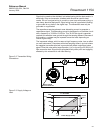
Reference Manual
00809-0100-4514, Rev BA
January 2008
2-5
Rosemount 1154
Signal wiring need not be shielded, but twisted pairs yield the best results. In
electrically noisy environments, shielded cable should be used for best
results. Do not run signal wiring in conduit or open trays with power wiring, or
near heavy electrical equipment. Signal wiring may be ungrounded (floating)
or grounded at any place in the signal loop. The transmitter case may be
grounded or ungrounded.
The capacitance-sensing element uses alternating current to generate a
capacitance signal. This alternating current is developed in an oscillator circuit
with a frequency of 32,000 ±10,000 Hz. This 32,000 Hz signal is capacitor
coupled to transmitter case ground through the sensing element. Because of
this coupling, a voltage may be imposed across the load, depending on
choice of grounding.
The impressed voltage, which is seen as high frequency noise, has no effect
on most instruments. Computers with short sampling times in a circuit where
the negative transmitter terminal is grounded will detect a significant noise
signal. Filter this noise with a large capacitor (1 µf) or by using a 32,000 Hz LC
filter across the load. Signal loops grounded at any other point are negligibly
affected by this noise and do not need filtering.
Figure 2-2. Transmitter Wiring
Connections.
Figure 2-3. Supply Voltage vs.
Load.
Power
Supply
Terminal Side
Cover Removed
4—20 mA DC
Design
Region
Qualified
Region
1825
1575
1500
1000
500
0
0
12
13.5
35
40
45
50
Power Supply (V DC)
Load Resistance (Ω)


















